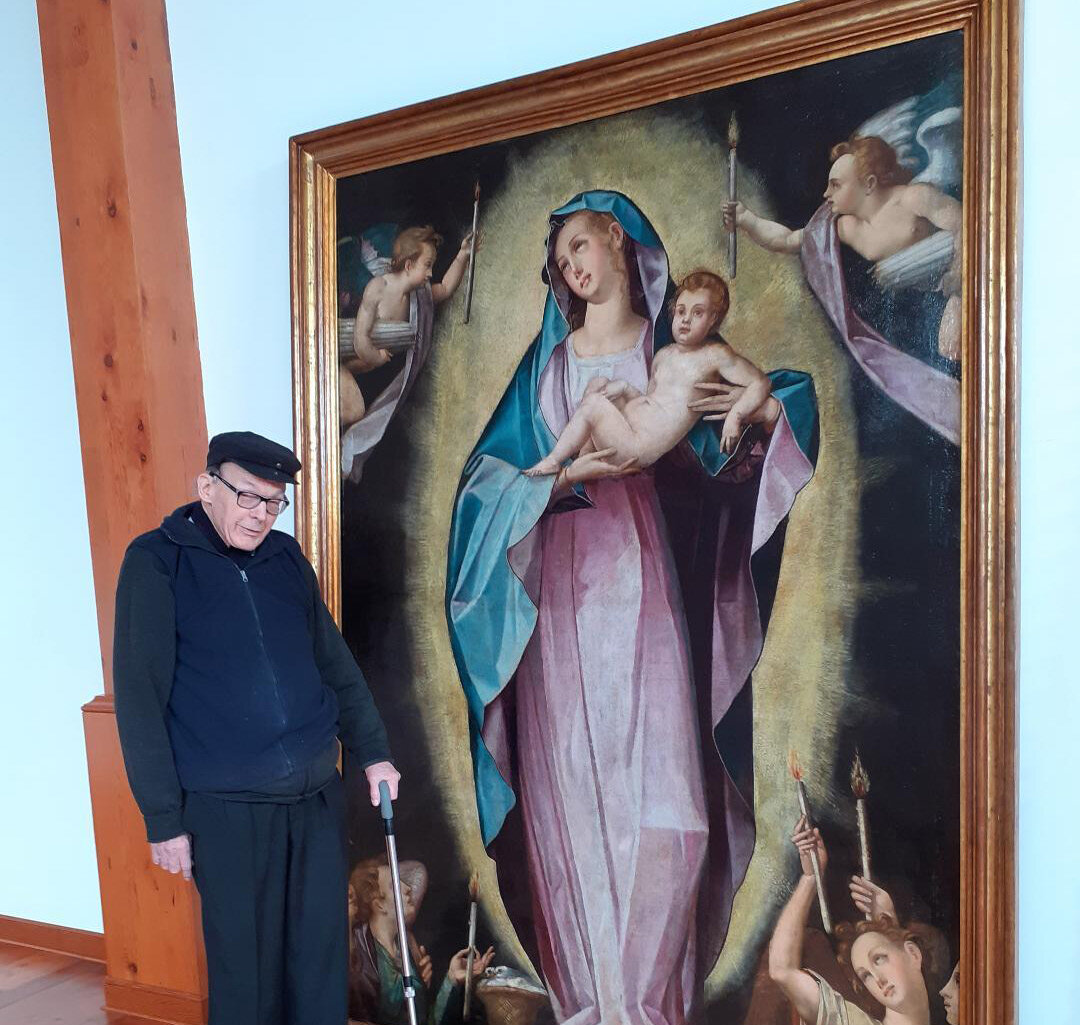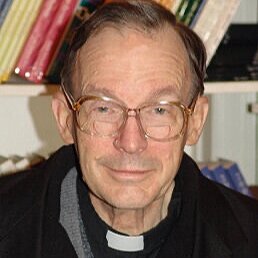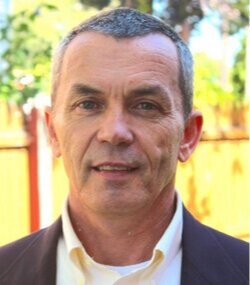
By Fr. Charlie Murtaugh, SJ
Fr. Murtaugh with a painting of the Virgin Mary by Br. Bernardo Bitti, SJ (1548–1610)
Since August of 2018, I have been at the Parish of San Pedro in Lima, Peru. It is a colonial church dating back to the arrival of the first Jesuits to come from Europe. The Jesuits were sent by St. Francis Borgia, SJ, in the second wave of missionaries. The church that we are in is one of two so-called “confessionals of Lima,” where people come from all over to go to confession every day for most of the day. The fact that I lost my capacity to walk by walking too much on my previous assignments helps to keep me in the church and mostly in the confessional.
Of course, the COVID-19 pandemic changed all this, but we hope that it will fully go away eventually. The church is downtown, and that means very few people live close by. The question is whether they will all come back after the pandemic is over. Will it ever be over, or will it just begin to fade with the passage of time?
Before I got to San Pedro, I was in Trujillo, Peru, at a parish that celebrated Mass twice daily during the week and three times on Sundays. There were also two chapels with Masses on weekends. I had a Mass in a different place each weekday morning. Then I had to see to it that the place kept running— gathering supplies and legal documents, repairing broken things, etc. Sometimes there were funeral Masses or visits to sick people. In the afternoons, the parish office was open to prepare for baptisms, matrimonies, and plenty of unexpected things. Several confessions and meetings of parish groups took place in the evenings. Three or four of us were there at a time.
Fr. Charlie Murtaugh, SJ, is a Jesuit of the Midwest Province, originally from Chicago. He currently resides in Lima, Peru, where he serves at the Parish of San Pedro.
Sometimes you hear teachers say that they have learned more from their students than their students have learned from them. This is certainly true in my case, and I think everybody feels something similar. I am favorably impressed with the number and quality of spontaneous groups that arise. Many of them are inspired by a patron saint, and people will organize an annual procession, complete with a festival; prepare and sell food; and then contribute to a worthy cause. If someone in a group tries to say, “Instead of making 50 sandwiches, I will just donate money,” the answer is usually, “We want your active participation, too.” There are groups dedicated to Bible study, charismatic prayer, visiting the sick, choirs, liturgy, and more.
Working with the parish groups has helped my own prayer life. Some things I have done were just “doing my job,” such as saving the house when the sewers were being replaced on our street and the sewage started flooding us. That was just “doing my job,” but dealing with the people in a pastoral setting is really living.
Creighton University dental students volunteered at the SFM Dental Clinic in March, when it reopened for the first time in over a year.
Thomas Drexler is a major gifts officer for the Midwest Jesuits and former executive director of the Ignatian Spirituality Project. He is a graduate of Marquette University High School, Creighton University, and Washington Theological Union.
Everyone wants to keep their teeth in good shape for the long haul. The simplest way to do this is daily brushing and regular preventative dental care. For the past nine years, the St. Francis Mission (SFM) Dental Clinic has offered care to the Lakota people of the Rosebud Indian Reservation in South Dakota. The clinic began in 2013 after conversations between Fr. John Hatcher, SJ, then president of St. Francis Mission; Dr. Jack Boarini, a Loyola School of Dentistry alumnus; and Dr. Boarini’s sons, who were visiting the reservation. To operate as a dental clinic, an LLC needed to be formed, consisting of three dentists from South Dakota. Today the LLC operates as a free, four-chair clinic serving the Lakota people. Each year, there are 20–25 clinic sessions, and over 1,200 patients are served. The clinic was forced to close during the beginning of the COVID-19 pandemic, but it reopened in March 2021 and is once again ramping up its services.
The need is great; an American Dental Association study found that 90% of the Lakota people on the Rosebud Indian Reservation have chronic tooth decay or gum disease, and a 2014 Indian Health Services (IHS) survey found that preschool-aged Native American children had four times more cases of untreated tooth decay than non-Hispanic white children. Paul Knecht, executive director of the South Dakota Dental Association, says there is a “chronic shortage of dental providers, and there are no private practices on the reservations. Most oral health care is provided through IHS, and they have challenges in budgeting and recruiting providers.”
Clinic director and registered dental hygienist Marty Jones, who has spent 40 years serving this population, says that one advantage of having the clinic on the reservation is accessibility and trust. “We provide a service similar to private settings, but they don’t have to jump through hoops to get these services,” says Jones. “There is also an element of trust that exists between the clinic’s staff and volunteers and those receiving care.” Jones also spoke of the clinic’s emphasis on education and preventative care: “We can’t rely on drilling and filling to get us out of this dental health problem.” Besides Jones, the staff includes a dental assistant and a receptionist/billing clerk, the latter due to a grant. Jones and her small staff are all members of the Sicangu Lakota Nation.
The SFM Dental Clinic is vital to the people on the Rosebud Indian Reservation. Knecht calls it a “beacon of light.”
Rosalee Whirlwind Soldier was incredibly happy when she learned of the dental clinic. Though two of her teeth needed to be pulled, four decaying teeth were able to be saved. Whirlwind Soldier is thrilled by the clinic’s impact on the community, saying, “My beautiful Native people have smiles now.”
The clinic relies on the generosity of volunteer dentists and dental hygienists who come from across the country. Jeff Olson, DDS, a member of the LLC, says the goal is to have a dentist working at the clinic daily. “The need is so great we could have three dentists seven days week,” says Dr. Olson, a 1988 graduate of Creighton University’s School of Dentistry.
Dr. Olson volunteers four times a year, often supervising dental students from Creighton. In addition to working in the clinic, volunteers learn about and experience Lakota culture. Another volunteer and member of the LLC, Chuck Scanlon, DDS, Creighton Dental ’08, spoke of getting involved in the community while there, including sharing meals with students at Sapa Un Catholic Academy.
Father James Kubicki, SJ, president of St. Francis Mission, is proud of the clinic’s success. “We are able to provide services that are otherwise not available to people here, like root canals, crowns, and dentures.” He credits “the leadership and hard work of Marty Jones [and] the many volunteer dentists and hygienists and dental students who come from all over the country.”
IN THIS ISSUE
Photo: Steve Donisch







